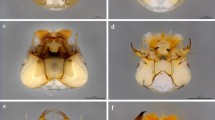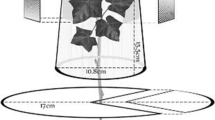Abstract
In tropical freshwaters, different species of water bugs (Heteroptera) constitute a guild sharing similar prey resources including chironomid and mosquito larvae. Assuming possibilities of intraguild predation (IGP) among the constituent members, an attempt was made to evaluate the effects of prey and predator density on the mortality of mosquito and chironomid larvae (shared prey), using Laccotrephes griseus Guérin-Méneville (Hemiptera: Nepidae) and Ranatra filiformis Fabricius (Hemiptera: Nepidae) as IG predators and Anisops bouvieri Kirkaldy (Hemiptera: Notonectidae) as IG prey. The predation on mosquito and chironomid larvae varied with the density and combinations of the predators. When present as conspecific IG predators, L. griseus exhibited greater effect on the prey mortality than R. filiformis. The effects on shared prey suggest that the two predators are not substitutable in terms of the effect on the shared prey mortality. The mortality of A. bouvieri (IG prey) at low shared prey density was significantly different (p < 0.05) from high shared prey density. In view of predatory effect of the heteropteran predators on the dipteran larvae, the results suggest possible interference by the presence of A. bouvieri as an intermediate predator. It seems that the presence of heteropteran predators including A. bouvieri as IG prey may benefit the dipteran prey under situations when the density is low in tropical waters. The intensity of the predatory effect may differ based on the species composition at IG predator level. For mosquito biological control, the interactions between the predators may not be substitutable and are independent in their effects.







Similar content being viewed by others
References
Addinsoft SARL (2010) XLSTAT software, version 9.0. Addinsoft, Paris
Aditya G, Bhattacharya S, Kundu N, Saha GK, Raut SK (2004) Predatory efficiency of the water bug Sphaerodema annulatum on mosquito larvae (Culex quinquefasciatus) and its effect on adult emergence. Bioresour Technol 95:169–172
Aditya G, Bhattacharya S, Kundu N, Saha GK (2005) Frequency dependent prey selection of predacious water-bugs on Armigeres subalbatus immatures. J Vector Borne Dis 42:9–14
Ambrose T (1985) Assimilation efficiency of biocontrol agents (Gambusia affinis, Laccotrephes griseus and Gerris (A) spinolae) on larval mosquitoes. Environ Ecol 14(2):471–472
Arim M, Marquet PA (2004) Intraguild predation: a widespread interaction related to species biology. Ecol Lett 7:557–564
Bailey PCE (1985) ‘A prey in the hand’, multi- prey capture behaviour in a sit-and-wait predator, Ranatra dispar (Heteroptera:Nepidae), the water stick insect. J Ethol 3:105–112
Bailey PCE (1986) The feeding behavior of a sit- and wait- predator Ranatra dispar (Heteroptera:Nepidae):optimal foraging and feeding dynamics. Oecologia 68:291–297
Bailey PCE (1987) Abundance and age-specific spatial and temporal distribution in two water- bug species, (Heteroptera:Notonectidae) and Ranatra dispar (Heteroptera:Nepidae) in farm dams in South Australia. Oikos 49:83–90
Bambaradeniya CNB, Edirisinghe JP, Silva DN, Gunatilleke CVS, Ranawana KB, Wijekoon S (2004) Biodiversity associated with rice agro-ecosystem in Sri Lanka. Biodivers Conserv 13:1715–1753
Banerjee S, Aditya G, Saha N, Saha GK (2010) An assessment of macroinvertebrate assemblages in mosquito larval habitats—space and diversity relationship. Environ Monit Assess 168:597–611
Bence JR (1988) Indirect effects and biological control of mosquitoes by mosquitofish. J Appl Ecol 25:505–521
Blois C, Cloarec A (1983) Density-dependent prey selection in the water stick insect, Ranatra linearis (Heteroptera). J Anim Ecol 52:849–866
Brahma S, Aditya G, Sharma D, Saha N, Kundu M, Saha GK (2014) Influence of density on intraguild predation of aquatic Hemiptera (Heteroptera): implications in biological control of mosquito. J Entomol Acarol Res 46:1977
Chacón JM, Heimpel GE (2010) Density-dependent intraguild predation of an aphid parasitoid. Oecologia 164:213–220
Cottrell TE, Yeargan KV (1998) Intraguild predation between an introduced Lady beetle, Harmonia axyridis (Coleoptera: Coccinellidae), and a native Lady beetle, Coleomegilla maculata (Coleoptera: Coccinellidae). J Kansas Entomol Soc 7(2):159–163
Crumrine PW (2005) Size structure and substitutability in an odonate intraguild predation system. Oecologia 145:132–139
Crumrine PW (2010) Size-structured cannibalism between top predators promotes the survival of intermediate predators in an intraguild predation system. J N Am Benthol Soc 29(2):636–646
Crumrine PW, Crowley PH (2003) Partitioning components of risk reduction in a dragonfly-fish intraguild predation system. Ecology 84:1588–1597
Finke DL, Denno RF (2004) Predator diversity dampens trophic cascades. Nature 429:407–410
Flynn KE, Moon DC (2011) Effects of habitat complexity, prey type, and abundance on intraguild predation between larval odonates. Hydrobiologia 675:97–104
Gagnon A-É, Heimpel GE, Brodeur J (2011) The ubiquity of intraguild predation among predatory arthropods. PLoS One 6(11):e28061. doi:10.1371/journal. pone.0028061
Griffen BD, Byers JE (2006a) Partitioning mechanisms of predator interference in different habitats. Oecologia 146:608–614
Griffen BD, Byers JE (2006b) Intraguild predation reduces redundancy of predator species in multiple predator assemblage. J Anim Ecol 75:959–966
Griffen BD, Williamson T (2008) Influence of predator density on non-independent effects of multiple predator species. Oecologia 155:151–159
Griswold MW, Lounibos LP (2006) Predator identity and additive effects in a treehole community. Ecology 84:987–995
Holt RD (1977) Predation, apparent competition, and the structure of prey communities. Theor Popul Biol 12:197–229
Holt RD, Polis GA (1997) A theoretical framework for intraguild predation. Am Nat 149(4):745–764
Huang C, Sih A (1991) Experimental studies of direct and indirect interactions in a three trophic level stream system. Oecologia 85:530–536
Hurlbert SH (1984) Pseudoreplication and the design of ecological field experiments. Ecol Monogr 54:187–211
Ives AR, Cardinale BJ, Snyder WE (2005) A synthesis of subdisciplines: predator–prey interactions, and biodiversity and ecosystem functioning. Ecol Lett 8:102–116
Jayakumar E, Mathavan S (1985) Successful colonization of Laccotrephes griseus (Hemiptera: Nepidae). Curr Sci 54(5):342–344
Jayakumar E, Mathavan S (1991) Effects of temperature on the growth and bioenergetics of Laccotrephes griseus (Hemiptera: Nepidae). J Therm Biol 16(2):93–102
Johansson F (1993) Intraguild predation and cannibalism in Odonate larvae: effects of foraging behavior and zooplankton availability. Oikos 66:80–87
Kannappan P, Nishi R, Rao TKR (1990) Predatory efficiency of Laccotrephes griseus. Environ Ecol 8(4):1101–1104
Koss AM, Snyder WE (2005) Alternative prey disrupts biocontrol by a guild of generalist predators. Biol Control 32:243–251
Lucus E, Coderre D, Brodeur J (1998) Intraguild predation among aphid predators: characterization and influence of extraguild prey density. Ecology 79(3):1084–1092
Lupi D, Locco A, Rosarro B (2013) Benthic macroinvertebrates in Italian rice fields. J Limnol 72(1):184–200
Manna B, Aditya G, Banerjee S (2008) Vulnerability of the mosquito larvae to the guppies (Poecilia reticulata) in the presence of alternative prey. J Vector Borne Dis 45:200–206
Manna B, Aditya G, Banerjee S (2011) Habitat heterogeneity and prey selection of Aplocheilus panchax: an indigenous larvivorous fish. J Vector Borne Dis 48:144–149
McCoy MW, Stier AC, Osenberg CW (2012) Emergent effects of multiple predators on prey survival: the importance of depletion and the functional response. Ecol Lett 15:1449–1456
Mogi M (2007) Insects and other invertebrate predators. J Am Mosq Control Assoc 23:93–109
Morin PJ (1995) Functional redundancy, non-additive interactions, and supply-side dynamics in experimental pond communities. Ecology 76:133–149
Muller CB, Brodeur J (2002) Intraguild predation in biological control and conservation biology. Biol Control 25:216–223
Nandi S, Aditya G, Saha GK (2012) Nutrient condition and chironomid assemblages in Kolkata, India: assessment for biomonitoring and ecological management. J Limnol 71(2):320–329
Neetha V, Venkatesan P (2005) Multispecies effects in the predatory performance of water bugs exposed to Culex larvae. J Entomol Res 29(2):99–103
Ohba S, Swart CC (2009) Intraguild predation of water scorpion Laccotrephes japonensis (Nepidae: Heteroptera). Ecol Res 24:1207–1211
Otto SB, Berlow EL, Rank NE, Smiley J, Brose U (2008) Predator diversity and identity drive interaction strength and trophic cascades in a food web. Ecology 89(1):134–144
Peckarsky BL (1991) Habitat selection by stream-dwelling predatory stoneflies. Can J Fish Aquat Sci 48:1069–1976
Pinder LCV (1995) The habitats of chironomid larvae. In: Armitage PD, Cranston PS, Pinder LCV (eds) The chironomidae: biology and ecology of non- biting midges. Chapman & Hall, London, pp 107–135
Polis GA, Myers CA, Holt RD (1989) The ecology and evolution of intraguild predation: potential competitors that eat each other. Annu Rev Ecol Syst 20:297–330
Quiroz-Martinez H, Rodriguez-Castro A (2007) Aquatic insects as predators of mosquito larvae. J Am Mosq Control Assoc 23(2):110–117
Rosenheim JA, Wilhoit LR, Armer CA (1993) Influence of intraguild predation among generalist insect predators on the suppression of an herbivore population. Oecologia 96:439–449
Rosemheim JA, Kaya H, Ehler LE, Marois JJ, Jaffee BA (1995) Intraguild predation among biological-control agents: theory and evidence. Biol Control 5:303–335
Saha N, Aditya G, Bal A, Saha GK (2007a) A comparative study of predation of three aquatic hemipteran bugs on Culex quinquefasciatus larvae. Limnology 8:73–80
Saha N, Aditya G, Bal A, Saha GK (2007b) Comparative study of functional response of common Hemipteran bugs of East Calcutta wetlands, India. Int Rev Hydrobiol 92:242–257
Saha N, Aditya G, Saha GK (2009) Habitat complexity reduces vulnerability of prey: an experimental analysis using aquatic insect predators and dipteran immatures. J Asia Pac Entomol 12:233–239
Saha N, Aditya G, Saha GK, Hampton SE (2010) Opportunistic foraging by heteropteran mosquito predators. Aquat Ecol 44:167–176
Schmitz OJ (2007) Predator diversity and trophic interactions. Ecology 88(10):2415–2426
Schmitz OJ, Sokol-Hessner L (2002) Linearity inthe aggregate effects of multiple predators in a food web. Ecol Lett 5:168–172
Sih A (1981) Stability, prey density and age-dependent interference in an aquatic insectpredator, Notonecta hoffmanni. J Anim Ecol 50:625–636
Sih A, Englund G, Wooster D (1998) Emergent impacts of multiple predators on prey. Trends Ecol Evol 13:350–355
Snyder WE, Clevenger GM, Eigerbrode SD (2004) Indraguild predation and successful invasion by introduced ladybird beetles. Oecologia 140:559–565
Soluk DA (1993) Multiple predator effects: predicting combined functional response of stream fish and invertebrate predators. Ecology 74:219–225
Soluk DA, Collins NC (1988) Synergistic interactions between fish and stoneflies-facilitation and interference among stream predators. Oikos 52:94–100
Stav G, Blaustein L, Margalit Y (2005) Individual and interactive effects of a predator and controphic species on mosquito populations. Ecol Appl 15:587–598
Wissinger S, Mcgrady J (1993) Intraguild predation and competition between larval dragonflies: direct and indirect effects on shared prey. Ecology 74:207–218
Zar JH (1999) Biostatistical analysis, IVth edn. Pearson Education (Singapore) Pte. Ltd, New Delhi
Acknowledgments
We thankfully acknowledge the suggestions of the anonymous reviewers that enhanced the manuscript to its present form. We thank Prof. Fernando Luis Consoli for his kind and constructive suggestions in reframing the manuscript. The authors are grateful to the respective Heads, Department of Zoology, University of Calcutta, Kolkata, India, and The University of Burdwan, Burdwan, India, for the facilities provided including DST-FISTand UGC-SAP (DRS I &II). GA acknowledges the financial assitance of UGC through Research Award [Sanction No F.30-90(SA-II)/2009;17.09.2009], in carryng out the work. SB acknowledges the financial assistance of UGC-RFSMS in carrying out this work.
Author information
Authors and Affiliations
Corresponding author
Additional information
Edited by Fernando L Cônsoli – ESALQ/USP
Rights and permissions
About this article
Cite this article
Brahma, S., Sharma, D., Kundu, M. et al. Intraguild Predation in Heteroptera: Effects of Density and Predator Identity on Dipteran Prey. Neotrop Entomol 44, 374–384 (2015). https://doi.org/10.1007/s13744-015-0286-5
Received:
Accepted:
Published:
Issue Date:
DOI: https://doi.org/10.1007/s13744-015-0286-5




